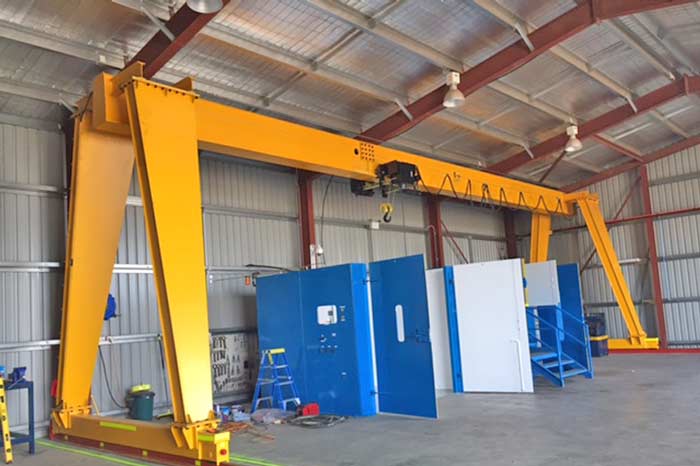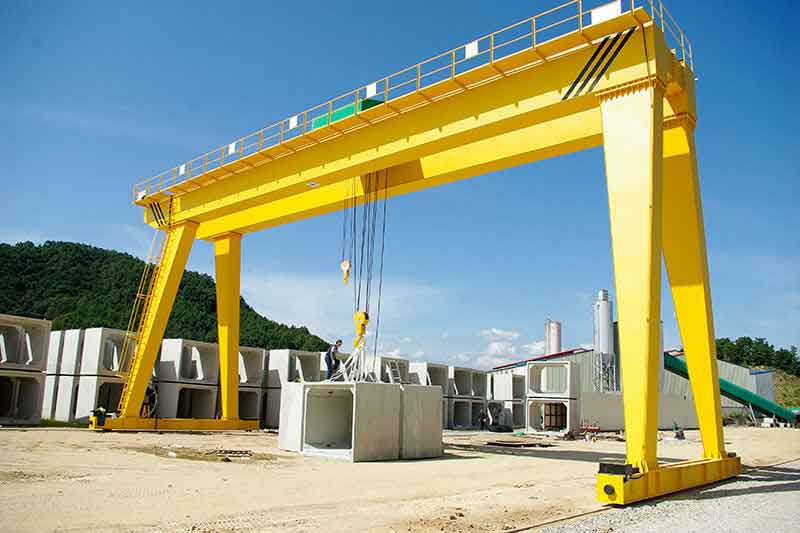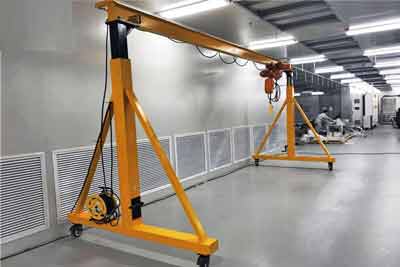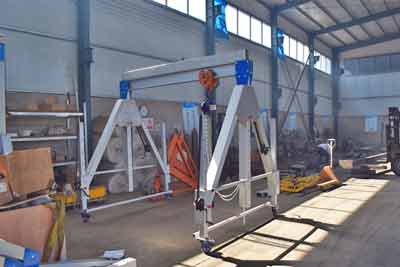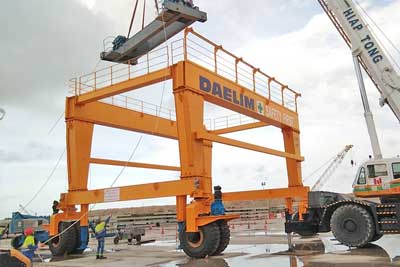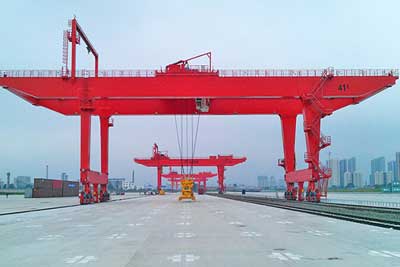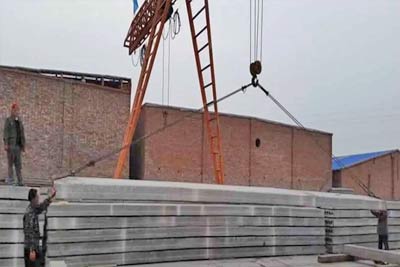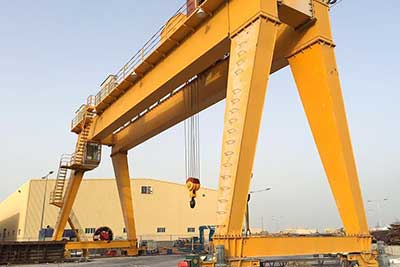What are Gantry Cranes & Types of Gantry Cranes Uses?
What is a Gantry Crane?
A gantry crane is a variation of overhead crane with freestanding legs that can move on wheels, a track or rail system embedded on the ground. The standard gantry crane can lift anything from a few hundred pounds to hundreds of tons, making it ideal for light and heavy lifting and construction jobs where an overhead bridge crane cannot.
Gantry Crane Types
There are numerous industrial gantry cranes available with varying lifting capacities. They are classified according to gantry crane size, girder configuration, design, and operating conditions. They are as follows:
Full gantry crane
The full gantry crane is the most common and common type of gantry crane. It is equipped with a crossbeam, a hoist, and two legs that can run on a track, wheels, or rails. Most of these standard gantry cranes are built in such a way that they leave enough room for other equipment to maneuver, and some are portable depending on their size.
Semi gantry crane or single leg gantry crane
The semi gantry crane type is one of the most adaptable, as it can be used both indoors and outdoors. It is notable for standing on one leg rather than two, with the other crane side supported by a wall or structure adjacent to it. A bridge, trolley, crane mechanism, and a hoist are all standard features of a semi-gantry crane.
Portable gantry crane or Rolling gantry cranes
These are lighter-duty gantry cranes of various shapes and sizes that are propelled by rubber wheels or casters. These small gantry cranes can be moved to any location, but their lifting capacity varies from half a ton to ten tons.
Adjustable height gantry crane
Adjustable gantry cranes are available in portable and fixed configurations and can be adjusted to meet the load requirements. The adjustable gantry cranes can be used for various application to meet various application conditions and lifting requirements.
What are gantry cranes used for?
Gantry cranes have a wide range of applications due to their high efficiency and performance. On the one hand, we can find them in enclosed spaces such as warehouses, workshops, garages, manufacturing and maintenance plants, and so on. On the other hand, the gantry crane is aslo commonly used in outdoor applications such as the port, dock, freight yard, shipyard, and so on.
Full gantry cranes and semi-gantry cranes are commonly used for heavy fabrication or in outdoor yards such as shipping yards, rail and container yards, and steelyards. Portable gantry cranes are used for small jobs and provide more flexibility than jib cranes or workstation cranes.
Operations a gantry crane can do for you
Load transportation
The heavy duty gantry cranes are those used to move heavy loads, particularly those used to load and unload containers from boats on decks and in harbors. There are also large gantry cranes capable of moving tens of thousands of tons that are used in the construction of boats, cruise ships, and oil rigs. In fact, the world's largest cranes are gantry cranes, which have a simple but effective design.
Load weighing
With a minor modification, the gantry crane can be used to precisely weigh heavy loads. There's no need to weigh a loaded lorry on an industrial scale to figure out how much material you're transporting or moving. Your gantry crane, equipped with a high-precision scale for large weights, will allow you to weigh while moving material within your manufacturing plant. We can modify them to fit your gantry crane.
Rotating loadsIt is a critical operation to turn heavy loads without damaging them or causing damage to goods, people, or infrastructure. It makes no difference whether it is a concrete structure, the keel of a boat, or any intermediate product that must be rotated in order to carry out more operations. A few tons falling on the floor due to a faulty load turning device results in significant economic and material loss, as well as possible damage to goods and infrastructure. Yuantai Crane can adapt your gantry crane to rotate any object with the appropriate hoist and mechanism. It makes no difference in terms of size, volume, or weight.
Industrial applications of gantry cranes
Gantry cranes are one of several types of lifting crane equipment that are equipped with a trolley and hoist to move heavy materials and loads. Gantry cranes are popular because, in addition to their high lifting capacity, they come in a wide range of sizes, from small enough for a workshop to massive enough for shipyards.
Gantry cranes' versatility makes them a valuable tool for both small and large industrial applications. A gantry crane is typically used instead of an overhead crane, which may not be appropriate for the application.
Manufacturing
Gantry cranes are commonly used in manufacturing to lift and move materials, supplies, and various goods and products. Because of the nature of their manufacturing processes, all types of gantry cranes are an essential part of the auto, steel, and aircraft industries. Gantry cranes are used in the installation and placement of engines in the automotive and aerospace industries.
Repair Services
In small engine repair shops, engines must be lifted and positioned so that the technician can inspect all parts of the engine. Large overhead cranes and simple winches are either impractical or inadequate for the task. As a result, repair shops rely on portable gantry cranes with the load capacity to lift an engine as well as the mobility to reposition it.
Shipyards
Shipyards are the most common application for large heavy duty gantry cranes; they are used to move extremely heavy loads and ship parts. From the engines that power the ships to the loads they carry, every aspect of a transport ship is large and heavy. Gantry cranes are an excellent choice due to their mobility and versatility. Shipyard applications necessitate the use of a variety of heavy duty gantry cranes for ship construction, repair, unloading, and material handling.
Warehouses
Gantry cranes are extremely useful in warehousing operations due to their versatility. Though it may be assumed that warehouses have space for overhead cranes, the structure of warehouse buildings in many cases cannot support them. Depending on the type of load being stored, warehouses typically employ a variety of gantry cranes. Warehouse cranes are typically required to be mobile in order to transport extremely heavy loads from unloading to loading.
Construction
Construction is another industry that relies on gantry cranes for their mobility and load capacity. Crews in the construction industry move in to build a structure or building, then quickly leave when the job is finished. This type of instant in and out necessitates the use of tools that can be used to meet the needs of the application but can also be disassembled and removed. Gantry cranes have become so important in the construction industry for these reasons. A large, A frame gantry crane is an ideal lifting solution because it can be positioned and assembled for the job, then removed.
Concrete blocks, extremely heavy steel support girders, and loads of lumber are among the items that a gantry crane must lift for construction. Overhead gantry cranes for construction, regardless of the project, are heavy duty single or double girder designs.
Shipping containers the size of a semitrailer and extremely heavy are transported by planes, trains, and ships as part of the supply chain. Unlike previous shipping containers, which could be moved by forklift, these massive, boxcar-sized containers are moved, positioned, and loaded using mobile gantry cranes, which efficiently lift them to be placed on trucks or trains.
Gantry cranes are an excellent choice for shipping container movement due to their high load capacity, mobility, and flexibility. A gantry crane's ease of use and safety improves its function and smooths loading processes.
All in all, the main application and usages of gantry cranes are as following :
Full gantry or semi-gantry cranes are commonly used in heavy fabrication applications or in outdoor yards such as rail yards, shipping and container yards, steel yards, and scrap yards.
They're also widely used in cement and precast applications for forming and curing slab concrete. Their design allows them to be used outside while also allowing forklift trucks and other motorized traffic to work and pass underneath.
Portable gantry cranes are typically used to lift and hold something in place while it is being repaired, fabricated, or assembled. Although the load is not necessarily moved throughout the facility, the gantry itself can be moved to work on different parts or equipment.
Portable gantry systems can also provide greater versatility than a jib crane or workstation crane. A jib crane is typically installed on a poured concrete foundation, and once installed, it is essentially permanent. A smaller portable gantry crane can do the same job as a jib crane, but it can be moved around your facility as your company grows and you start optimizing and laying out warehouse space.


